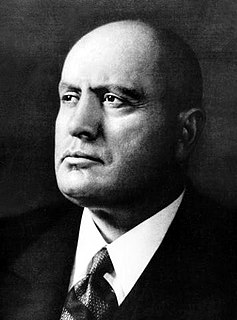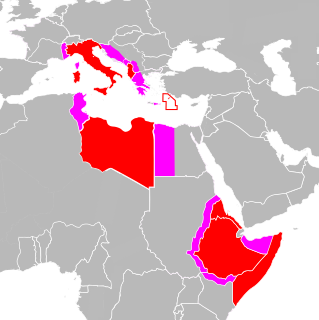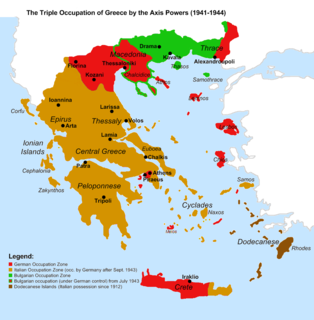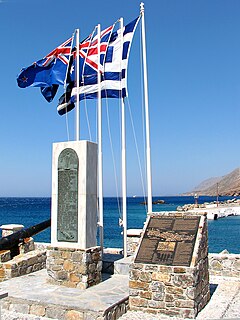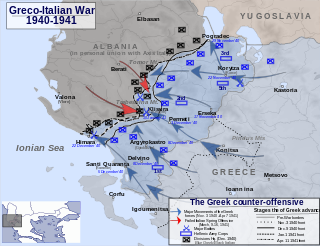This article needs additional citations for verification .(February 2017) (Learn how and when to remove this template message) |
| Balkans Campaign | |||||||||
|---|---|---|---|---|---|---|---|---|---|
| Part of Mediterranean and Middle East Theatre of the Second World War | |||||||||
 German paratroopers on Crete in 1941 | |||||||||
| |||||||||
| Belligerents | |||||||||
(From March 1941) | Allies : | ||||||||
| Commanders and leaders | |||||||||
| Strength | |||||||||
The Balkans Campaign of World War II began with the Italian invasion of Greece on 28 October 1940. In the early months of 1941, Italy's offensive had stalled and a Greek counter-offensive pushed into Albania. Germany sought to aid Italy by deploying troops to Romania and Bulgaria and attacking Greece from the east. Meanwhile, the British landed troops and aircraft to shore up Greek defences. A coup d'état in Yugoslavia on 27 March caused Adolf Hitler to order the conquest of that country.

World War II, also known as the Second World War, was a global war that lasted from 1939 to 1945. The vast majority of the world's countries—including all the great powers—eventually formed two opposing military alliances: the Allies and the Axis. A state of total war emerged, directly involving more than 100 million people from over 30 countries. The major participants threw their entire economic, industrial, and scientific capabilities behind the war effort, blurring the distinction between civilian and military resources. World War II was the deadliest conflict in human history, marked by 50 to 85 million fatalities, most of whom were civilians in the Soviet Union and China. It included massacres, the genocide of the Holocaust, strategic bombing, premeditated death from starvation and disease, and the only use of nuclear weapons in war.

The Greco-Italian War took place between the kingdoms of Italy and Greece from 28 October 1940 to 23 April 1941. This local war began the Balkans Campaign of World War II between the Axis powers and the Allies. It turned into the Battle of Greece when British and German ground forces intervened early in 1941.

The Kingdom of Romania was a constitutional monarchy that existed in Romania from 26 March 1881 with the crowning of prince Karl of Hohenzollern-Sigmaringen as King Carol I, until 1947 with the abdication of King Michael I of Romania, and the Romanian parliament proclaiming Romania a socialist republic.
Contents
- Background
- Campaign
- Greco-Italian War
- Invasion of Yugoslavia
- Battle of Greece
- Battle of Crete
- Result
- Bulgarian occupation
- Resistance movements
- See also
- References
- External links
The invasion of Yugoslavia by Germany and Italy began on 6 April, simultaneously with the new Battle of Greece; on 11 April, Hungary joined the invasion. By 17 April the Yugoslavs had signed an armistice, and by 30 April all of mainland Greece was under German or Italian control. On 20 May Germany invaded Crete by air, and by 1 June all remaining Greek and British forces on the island had surrendered. Although it had not participated in the attacks in April, Bulgaria occupied parts of both Yugoslavia and Greece shortly thereafter for the remainder of the war in the Balkans.
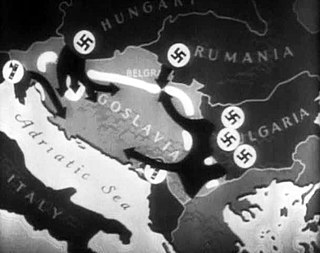
The invasion of Yugoslavia, also known as the April War or Operation 25, was a German-led attack on the Kingdom of Yugoslavia by the Axis powers which began on 6 April 1941 during World War II. The order for the invasion was put forward in "Führer Directive No. 25", which Adolf Hitler issued on 27 March 1941, following the Yugoslav coup d'état.

The Battle of Greece is the common name for the invasion of Allied Greece by Fascist Italy and Nazi Germany in April 1941 during World War II. The Italian invasion in October 1940, which is usually known as the Greco-Italian War, was followed by the German invasion in April 1941. German landings on the island of Crete came after Allied forces had been defeated in mainland Greece. These battles were part of the greater Balkan Campaign of Germany.

The Battle of Crete was fought during the Second World War on the Greek island of Crete. It began on the morning of 20 May 1941, when Nazi Germany began an airborne invasion of Crete. Greek and other Allied forces, along with Cretan civilians, defended the island. After one day of fighting, the Germans had suffered heavy casualties and the Allied troops were confident that they would defeat the invasion. The next day, through communication failures, Allied tactical hesitation and German offensive operations, Maleme Airfield in western Crete fell, enabling the Germans to land reinforcements and overwhelm the defensive positions on the north of the island. Allied forces withdrew to the south coast. More than half were evacuated by the British Royal Navy and the remainder surrendered or joined the Cretan resistance. The defence of Crete evolved into a costly naval engagement; by the end of the campaign the Royal Navy's eastern Mediterranean strength had been reduced to only two battleships and three cruisers.





